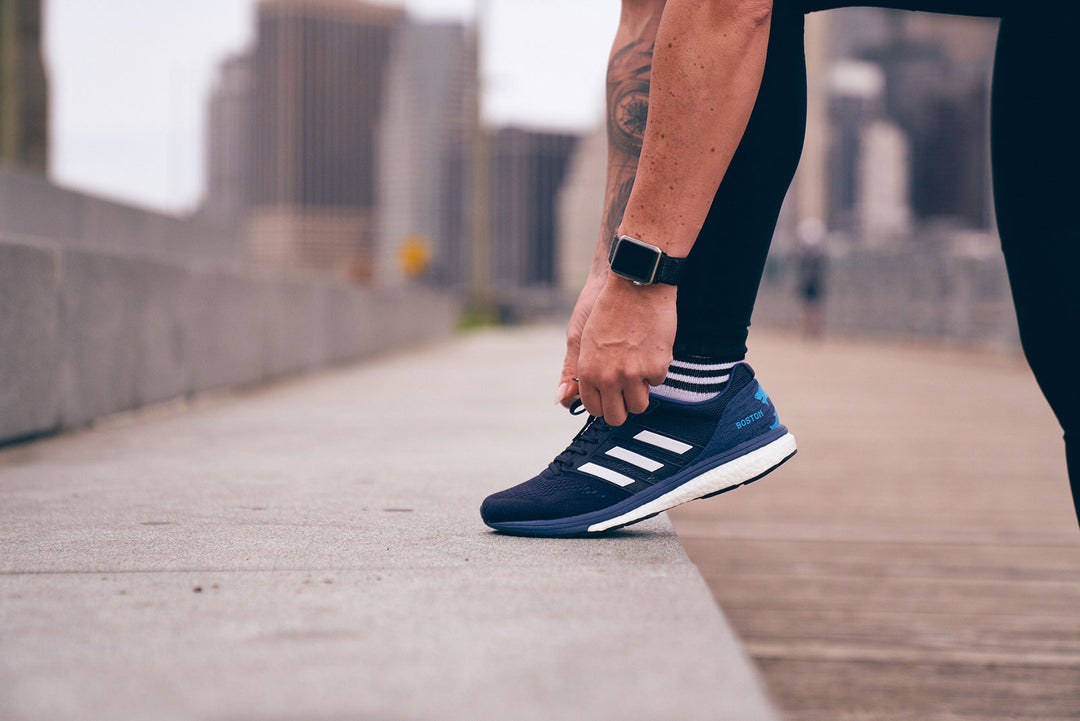Running on the beach
Last Updated:
Why you can trust Sabrina Wieser
Runningbrina is committed to bringing you unbiased ratings and information. Her editorial content is not influenced by advertisers. Sabrina uses data-driven methodologies to evaluate all products, so all brands are measured equally.
- Most featured running blog, past 6 years
- USATF certified running coach
- Experienced endurance athlete
- 7 marathons
If you’re leaving for vacation, and you are planning on taking your love for running to the shoreline, you should read these tips for running on the beach before you do so. It is one of the most beautiful places a runner can get a workout done, but it is important to know some pointers before you get ready.
While doing research for this article I’ve spoken to somebody who knows every point of advice when it comes to beach runs. Robert “Raven” Kraft (born 1950 from Miami – a man who has seen every single sunset for the past four decades from a strip of sand now called South Beach. His total miles for now? 124,398!
RUNNING ON THE BEACH: WHAT YOU SHOULD KNOW
Running on the beach is quite a challenge. You can ask anyone who ever ran on the sand, it’s way more intense than running on regular pavement. In 1996, researchers found out that beach running takes 1.6 times more energy than running on the road. But why is that? Running on the beach requires more mechanical work. In addition, because the sand has such an unpredictable surface, your tendons and muscles use more energy when transferring your weight and while staying stabilized. Running on the beach is hard work!BEACH RUNS DO’S
If you are new to running on the beach, it is important to allow your body to get used to the new running surface. Also, make sure you always wear sunscreen. A good time to go for a run on the beach will be in the morning before the sun comes out and the temperature starts to rise. Proper hydration is a must as well.RUNNING ON THE BEACH BAREFOOT?
Running barefoot is an amazing feeling of our natural range of motion within our feet. It will also help strengthen your feet and ankles. But keep in mind that running on the beach with no shoes requires experience. This is why you shouldn’t go for your first run on the beach without shoes. Running barefoot on sand might lead to plantar fasciitis, ankle sprains, or even injuries to the Achilles tendon because your feet aren’t getting any support from your running shoes. Your muscles stretch longer on the beach than they would on a harder surface. Also, most beaches tend to have a lot of shells and other sharp objects that might hurt you while you’re running on the beach. If you still want to try to run barefoot on the beach and haven’t done it before, start with shorter runs, so that your feet and muscles have time to adapt to the new environment. Barefoot running on the beach is possible on some beaches, but eventually, it will wear out the skin on your feet. As Raven says: “Running on the beach with shoes on is the better option” Unfortunately there aren’t any shoes out there, which were designed for beach runs. So try to get light shoes with a mesh that doesn’t let sand in. If you didn’t bring any of these kinds of shoes on your vacation, your regular running shoe will be just fine as well. It’s unavoidable to keep sand out of your shoes, so wear socks that prevent blisters, or put some Vaseline or similar products on your feet before running on the beach.What to wear running on the beach?
While running on the beach it is important to wear technical fabrics—sweat-wicking, breathable shorts and tops, and something you won't mind getting wet. I'd always recommend covering your skin as much as possible to protect your skin from the sunlight. You should wear a lightweight hat to protect yourself from the sun (put sunscreen on) and wear sunglasses as well. If you decide to run with shoes on the sand, make sure to wear proper beach running shoes. Thing and airy running socks will be best for beach running.What are the best shoes for running on the beach?
Is it better to run on the beach with shoes? Running barefoot is always an option, but a risky one at that if you’re not conditioned enough. For most, it’s a safer bet to get a good pair of shoes for your running to prevent ankle, foot, or knee injuries. Keep in mind that everyone’s anatomy and physiology is different, so finding the right pair of shoes for you is truly up to the individual. Running shoes for beach running with a tight or completely closed mesh upper will help keep sand out of your shoes. Having said that, here are some of my favorite running for beach running:THE RAVEN RUN IN MIAMI
 I travel to Miami all the time, and I really love running while I’m there. I especially enjoy running on the beach! There is one runner in Miami who has inspired me since the first day I saw him running on the beach. Raven from Miami is a motivating and remarkable runner. You don’t find people every day who truly found their mission in life. Raven runs 8 miles on the beach every single day. He hasn’t missed a day yet. In the first 8 years, he ran alone. All by himself. Every afternoon. No one in the world has run more miles on the sand than him.
I travel to Miami all the time, and I really love running while I’m there. I especially enjoy running on the beach! There is one runner in Miami who has inspired me since the first day I saw him running on the beach. Raven from Miami is a motivating and remarkable runner. You don’t find people every day who truly found their mission in life. Raven runs 8 miles on the beach every single day. He hasn’t missed a day yet. In the first 8 years, he ran alone. All by himself. Every afternoon. No one in the world has run more miles on the sand than him.
2600 RUNNERS. 87 DIFFERENT COUNTRIES
 And today more than 2600 runners from 87 different countries have completed the Raven Run in Miami. Everyone who runs all eight miles on one of Raven’s daily runs earns a nickname from Raven himself. Raven is a total expert when it comes to running on the beach. For him, it’s a celebration of life. Running with Raven in Miami isn’t a race; it’s a way of being on the beach in Miami – running along the Atlantic Ocean – watching one of the most beautiful sunsets. Raven is someone I look up to because he has the strength of commitment. He is one of a kind and inspires a whole running community all over the world. “I say, ‘If I can do it every day, you can do it once in a while,’ ” says Raven. “And no matter where they are, wherever in the world they are, they know what time I’m out there.” Running on the beach every day might sound boring to you, but for Raven, it has become his life. Even though he doesn’t race, the world is coming to him to run with him. Raven is a good example that running on the beach is something very special. There is something about it that makes it so enjoyable. I don’t even need music when I’m running next to the Ocean. I just like to listen to the sounds of the waves and breathe in the energy that comes with it.
And today more than 2600 runners from 87 different countries have completed the Raven Run in Miami. Everyone who runs all eight miles on one of Raven’s daily runs earns a nickname from Raven himself. Raven is a total expert when it comes to running on the beach. For him, it’s a celebration of life. Running with Raven in Miami isn’t a race; it’s a way of being on the beach in Miami – running along the Atlantic Ocean – watching one of the most beautiful sunsets. Raven is someone I look up to because he has the strength of commitment. He is one of a kind and inspires a whole running community all over the world. “I say, ‘If I can do it every day, you can do it once in a while,’ ” says Raven. “And no matter where they are, wherever in the world they are, they know what time I’m out there.” Running on the beach every day might sound boring to you, but for Raven, it has become his life. Even though he doesn’t race, the world is coming to him to run with him. Raven is a good example that running on the beach is something very special. There is something about it that makes it so enjoyable. I don’t even need music when I’m running next to the Ocean. I just like to listen to the sounds of the waves and breathe in the energy that comes with it.
RUNNING ON THE BEACH INJURIES
Looking at Raven Kraft today after 40 years of running on the beach his running form had morphed into a tanned and weathered question mark. Raven explained that his back dramatically arched and he suffers serious pain. Also, his chin is neatly tucked into his chest. Decades of running have worsened Raven’s scoliosis, sciatica, and spinal stenosis. The good thing is that Raven is still running, and he will continue doing so, balanced by an unwavering loyalty and generosity. Raven runs slower than before, but his passion for beach runs will never fade. Check out his website if you are planning on running with him in Miami. Have you ever ran on the beach? Leave me your favorite beach run experience in the comments. And check out an updated Q&A below for some additional information and findings on beach running. There are even some shoe recommendations for beach running!FAQ ABOUT BEACH RUNNING
BAREFOOT RUNNING TIPS
Although running on the beach is more challenging, and thus better for your conditioning, you need to build yourself up in strength before you rush madly into a thousand-yard dash, sans footwear. Because of the risk of injury when running barefoot in general, plus an uneven running surface like sand, you’re flirting with danger if you get too lax about training on the sand. Some of the best things to keep in mind for running on the beach:- Take your time and enjoy the experience. Don’t overwork yourself or run too fast and then get injured.
- Look for the flattest sections of the beach to avoid losing your balance and any breakdown in your form. This could even mean scoping out your route instead of running with reckless abandon.
- Get good shoes for the beach. Running barefoot has its unique benefits, but shoes should be a priority for the majority of training.
- Warm-up and stretch accordingly. The beach is beautiful and you might be excited to get running, especially on vacation, but curb your enthusiasm slightly and stretch first!









